Still I’m doing as I please.
Today was a day for exploring two adjoining neighborhoods – Parque das Naçoes and Marvila. If you recognize the former as the home to Estação Oriente, the Bordallo II Cat, and the Oceanarium and think that we’ve been there, you’re correct on all points. However, although I’d already been all of those places, I hadn’t really explored the neighborhood any further and, while I was (and remain), fairly certain that a more permanent return to Lisboa will find me settled in the same Baixa-Pombalina neighborhood where I’d spent this temporary stay, I didn’t want to dismiss out of hand other possibilities the city may offer.
Looking at the screen capture from Google Maps, you can see that the highlighted neighborhoods of Parque das Naçoes and Marvila are more or less adjacent
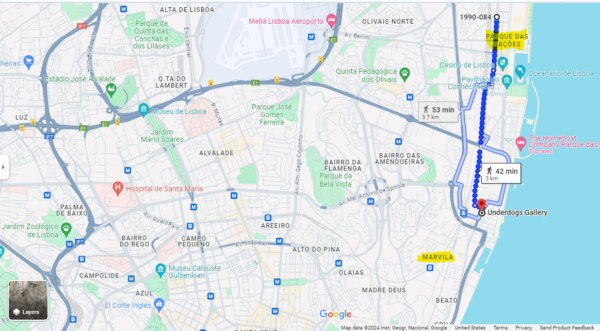
and because they’re close to the river they are also both relatively flat.
The website Hoodpicker has this description of Marvila:
Marvila is the ‘London East-End’ of Lisbon. It’s a trendy, up-and-coming area, perched on the side of the beautiful Tagus River. The neighborhood offers quirky stores, art galleries, and antiques. This is coupled with relatively low real estate prices. This has caught the attention of prospective homeowners.
However, looking at this map from the same site,
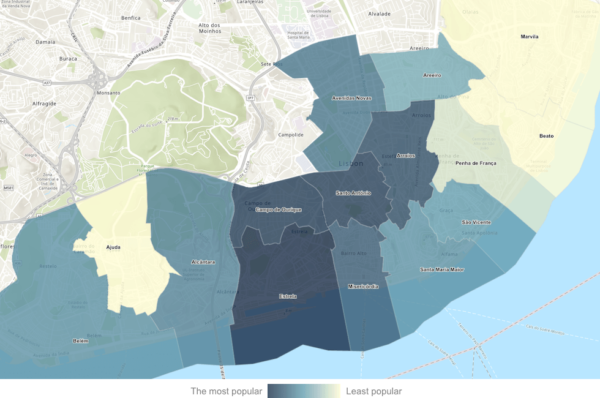
you can also see that Marvila is quite far from the city center which is close to the boundary between Santa Maria Maior and Misericórdia. And, while Hoodpicker also has a brief description of the Parque das Naçoes neighborhood, it’s so far to the north that it’s off their map.
It’s a nearly nine kilometer walk from Praça da Figueira (near my flat) to the Oriente Station so I rode the Metro there. It seemed a good place to start my exploration of the neighborhood and was a less than daunting three kilometer walk to the Underdogs Gallery – a place I’d intended to visit at Ana’s suggestion but failed to reach during my 2022-2023 stay.
Parque das Naçoes.
Although it’s less than half the size of Centro Colombo – Lisbon’s largest shopping mall – residents of Parqe das Naçoes can probably fill nearly all their shopping needs at the Centro Vasco da Gama across the street from the Oriente transit center and, of course there are buses, intercity trains, and a Metro station there. In this sense, this could be a comfortable and convenient neighborhood. Its also flat and its proximity to the rio Tejo is certainly another attractive element.
Although not at street level, this video provides an overview of what many call Lisbon’s newest neighborhood – one that Hoodpicker describes as “a futuristic, commercial hotspot.”
In one way, its assets are easily identifiable, I decided quite quickly that this is not a neighborhood in which I’d want to live. Despite having a major transit hub, it’s quite distant from the city center – closer, in my mind, to a suburb than to the city itself. And this presented another personal issue. Had it not been for the Calçadas Portugesas, (the stone sidewalks) and the signage in Portuguese, this area felt generic – as though it would be comfortable in any major city anywhere in the world. In other words, to me, it simply didn’t feel like Lisboa.
Before I leave, though, I will credit it with having one of the longest, most interesting, and creative stretches of wall art I saw on this stay in Lisboa. And, of course, it included

a turtle!
With Parque das Naçoes out, was Marvila marvelous?
In a word, no. At least not for me. Although it’s said to have a thriving arts district and my main intent was visiting the Underdogs Gallery it seemed to be slim in providing for some of life’s more prosaic concerns, such as, for example, a major grocery store. As for the gallery I planned to visit, it has limited hours and didn’t open until 14:00 which left me ample time to wander the neighborhood.
Parts of Marvila certainly felt more like Lisboa than the entirety of Parque das Naçoes. On the other hand, the “trendy up-and-coming” areas in Marvila felt like a close relative of its neighbor to the north. Thus, for example, one can walk through the section of Marvila called Poço do Bispo (Bishop’s Well) and see buildings like this old warehouse built in the early 20th century
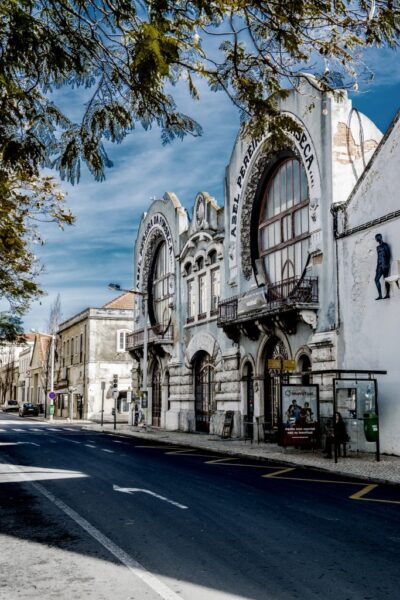
that until 1993 was used for marketing and distributing wine produced in Bonbarral – a region a bit south of Óbidos. There are also somewhat more modern warehouses such as the indoor space used by the Underdogs Gallery.

(I specify “indoor space” because of the Underdogs Public Art Programme. Part of their mission is “promoting art in the city as a public service. With the goal of establishing a close relationship between the artists we work with, the city of Lisbon, and its inhabitants…”)
and, as you approach the river, new buildings that, to me, clearly tag it as “trendy and up-and-coming” but that left me lukewarm.
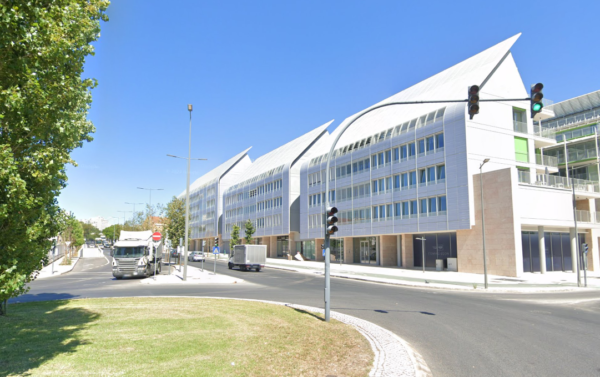
The walk along the river, where I stopped for a light bite and a chá preto, had an interesting sculpture installation called “the Stupid People Project” by Robert Panda who got his start in Lisbon’s graffiti underground. He hopes his sculptures surprise passers-by and even prompt people to interact with them. (Those with long memories might recall seeing another of Panda’s stupid people in the very first post of this series.)
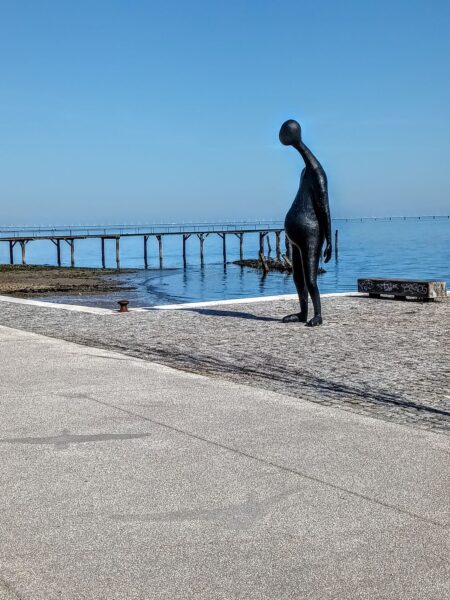
After my snack on a beautiful day to sit for awhile by the river, I started back to the Underdogs Gallery. On the way, I stopped to take a photo of this Monumento aos Construtores de Cidade (Monument to the Builders of the City)
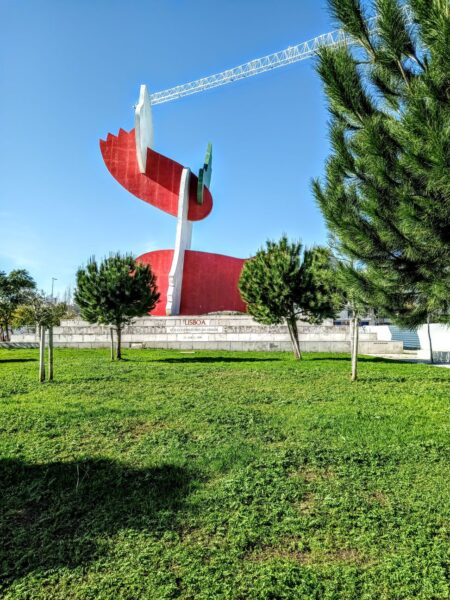
that serendipitously had a construction crane hovering above it. The monument was sculpted by José de Guimarães in 1999 and was initially intended for the riverside area, in front of the Cordoaria Nacional east of the 25th of April Bridge and more than 10 kilometers from its present location. However, seeing this 25-meter tall sculpture adjacent to those modern buildings I had to wonder if it might represent the type of neighborhood Marvila aspires to become. I also couldn’t help but compare it in my mind to the Monumento ao Calceteiro (Monument to the Pavers)
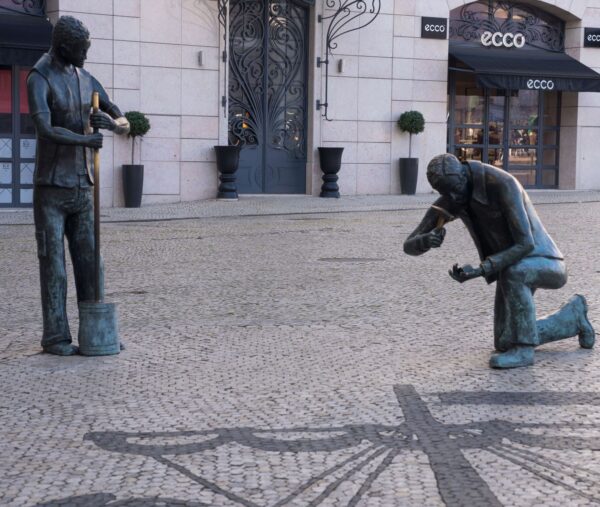
in Rossio in the heart of the old city. The former is nice but the latter better represents the Lisboa I love.
Underdogs at last.
I have to admit that the child in me hoped that when I finally reached the gallery I’d encounter Sweet Polly Purebred but such was not to be. The current exhibition was titled Between Two Waters and the gallery’s website provides this description,
Diving us into ambiguity, “Between Two Waters” presents a version of the world beyond certainty. Positioning itself in a space where the familiar coexists with the unknown, it challenges us to live in opacity, rejecting the notion that there are only two sides to every argument. Through works created by seven young Portuguese artists, the exhibition reveals the various ways in which art can generate ideas, perspectives, and positions that lie in the middle ground.
Through a collection of works that highlight the aesthetics and artistic approaches of their creators, “Between Two Waters” explores themes ranging from politics to ideology, from the inner world to the outer world, from the digital to the physical. Swimming against an increasingly extremist tide, this exhibition creates a space that safeguards the middle ground, emphasizing a contemporary reality in which we all need to learn to embrace uncertainty.
The show consisted of mainly giclée prints.
(Giclée blends a pair of French words – gicleur meaning nozzle or jet and gicler a verb meaning to spray out.
Credit for coining the term goes to printmaker Jack Duganne who first used it in 1991. Today, it’s come to describe any fine art printing using pigment based, archival quality inks, manufactured on advanced inkjet printers.)
Although I found one called Histopia 3 quite intriguing, I was uncertain whether I wanted to buy a print – even a signed, limited edition print. There was a second print that I liked but it had sold out.
With my combined missions accomplished, I followed the suggestion Ana had made more than a year ago (more specifically, followed it partially and in reverse). I got on the 728 bus and rode it back to Santa Apolónia to leave myself a respectable walk back to the flat.
You can see photos from the day by using this link.